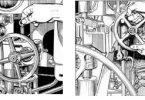The officer in charge of the navigational watch shall :
- keep the watch on bridge.
- in no circumstances leave the bridge until properly relieved and
- Continue to be responsible for the safe navigation of the ship, despite the presence of the master on the bridge, until informed specifically that the master has assumed that responsibility and this is mutually understood.
- During the watch, the course steered, position, and speed shall be checked at sufficiently frequent intervals, using any available navigational aids necessary, to ensure that the ship followed the planned course.
- The officer in charge of the navigational watch shall have full knowledge of the location and operation of all safety and navigational equipment on board the ship and shall be aware and take account of the operating limitations of such equipment.
- The officer in charge of the navigational watch shall not be assigned or undertake any duties which would interfere with the safe navigation of the ship.
- When using radar, the officer in charge of the navigational watch shall be bear in mind the necessity to comply at all times with the provisions on the use of radar contained in the international regulations for preventing collision at 1972 as amended en force.
- In cases of need the officer in charge of the navigational watch shall not hesitate to use the helm, engines and sound signaling apparatus. However, timely notice of intended variations of engine speed shall be given where possible or effective use shall be made of UMS engine controls provided on the bridge in accordance with the applicable procedures.
- Officers of the navigational watch shall know the handling characteristics of their ship, including its stopping distances and should appreciate the other ships may have different handling characteristics.
- A proper record shall be kept during the watch of the movements and activities relating to the navigation of the ship.
- It is of special importance that at all times the officer in charge of the navigational watch ensures that a proper lookout is maintained. In a ship with a separate chartroom, the officer in charge of the navigational watch may visit the chart room, when essential, for a short period for the necessary performance of navigational duties, but shall first ensure that it is safe to do so and that proper lookout is maintained.
- Operational taste of shipboard navigational equipment shall be carried out at sea as frequently as practicable and as circumstances permit, in particular before hazardous conditions affecting navigation are expected. Whenever appropriate, these tests shall be recorded. Such tests shall also be carried out prior to port arrival and departure.
The officer in charge of the navigational watch shall make regular checks to ensure that :
- The person steering the ship or the automatic pilot is steering the correct course.
- The standard compass error is determined at least once a watch and when possible, after any major alteration of course, the standard and gyro compasses are frequently compared and repeaters are synchronized with their master compass.
- The automatic pilot is tested manually at least once a watch.
- The navigation and signal lights and other navigational equipment are functioning properly.
- The radio equipment is functioning properly in accordance with paragraph 86 of this section and.
- UMS controls, alarms and indicators are functioning properly.
- The officer in charge of the navigational watch shall bear in mind the necessity to comply at all times with the requirements in force of the international convention for the safety of life at sea (SOLAS), 1974 (regulation V/24, V/25. and V/26). The officer of the navigational watch shall take into account :
- The need to station a person to steer the ship and to put the steering into manual control in good time to allow any potentially hazardous situation to be dealt with in a safe manner and,
- That with a ship under automatic steering, it is highly dangerous to allow a situation to develop to the point where the officer in charge of the navigational watch is without assistance and has to break the continuity of the lookout in order to take emergency action.
- Officers of the navigational watch shall be thoroughly familiar with the use of all electronic navigational aids carried, including their capabilities and limitations and shall use each of these aids when appropriate and shall bear in mind that the echo sounder is a valuable navigation aid.
- The officer in charge of the navigational watch shall use the radar whenever restricted visibility is encountered or expected, ahead at all times in congested waters, having due regard to its limitations.
- The officer is charge of the navigational watch shall ensure that the range scales employed are changed at sufficiently frequent intervals so that echoes are detected as early as possible. It shall be borne in mind that small or poor echoes may escape detection.
- Whenever radar is in use, the officer in charge of the navigational watch shall select an appropriate range scale and observe the display carefully and shall ensure that plotting or systematic analysis is commenced in ample time.


